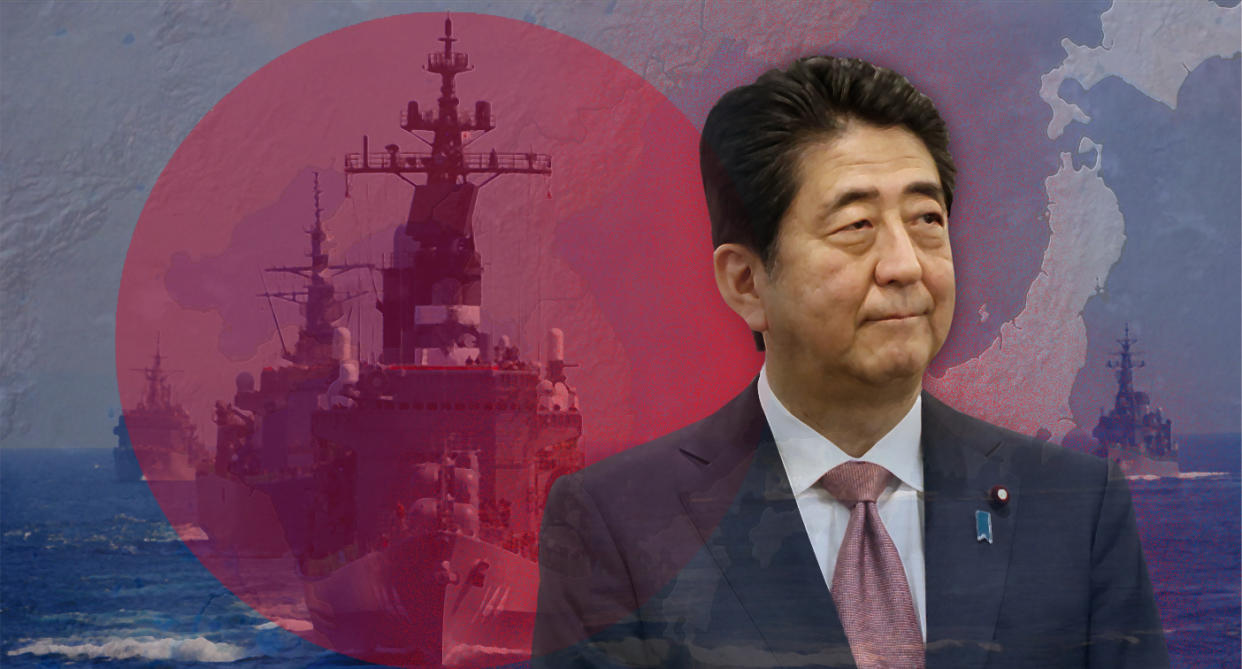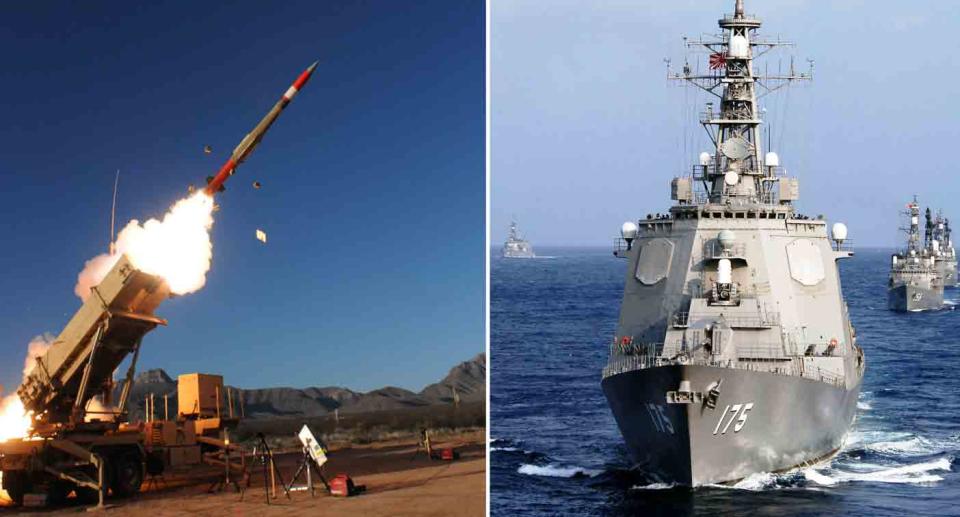Japanese defense in the age of North Korean missile successes

The United States and South Korea began large-scale air-defense exercises on Monday, ignoring pleas from Russia and China to call off the annual military drills in hopes that, in exchange, North Korea would slow its weapons programs. The decision signaled that the U.S. and its regional allies, including South Korea and Japan, are losing faith in the prospects for negotiations with the regime in Pyongyang.
“People may ask why we do not engage with North Korea. We have been engaging with North Korea for more than 20 years,” a Japanese government official told Yahoo News at the Ministry of Foreign Affairs headquarters in Kasumigaseki, Tokyo. “Our sincere will for dialogue with North Korea was betrayed, simply put.”
North Korea fired an intercontinental ballistic missile (ICBM) last week that flew higher and farther than any previous launches, before landing in the sea within 200 nautical miles of Japan’s coast. The launch defied international pressure for the nation to halt testing of offensive weapons.
The Kim Jong Un regime said the new Hwasong-15 ICBM reached an altitude of about 2,780 miles and traveled 590 miles during its 53-minute flight. U.S. Defense Secretary James Mattis said that Pyongyang was determined to build missiles that could “threaten everywhere in the world, basically.”
The Korean Central News Agency (KCNA), the state-run news agency for North Korea, claimed the “breakthrough” ICBM was robust enough to withstand reentering the atmosphere with a warhead and could reach the U.S. mainland.
The launch was North Korea’s first since President Trump put the country back on a list of state sponsors of terror on Nov. 20. It ended the fragile hope that stronger oil sanctions against North Korea would dissuade it from testing more ballistic missiles. The regime’s last ballistic missile exercise before last Tuesday took place on Sept. 15.
North Korea has tested ballistic missiles dozens of times over the past two years, rapidly increasing their reach — and altitude, which creates a lofted trajectory that’s more difficult to intercept.
The country has carried out six nuclear tests since October 2006. The government said the fifth test, on Sept. 9, 2016, was its first successful test explosion of a nuclear warhead – i.e., a bomb that could be delivered by a missile. After the sixth test, on Sept. 3, 2017, Pyongyang announced that it had successfully detonated a hydrogen bomb with an estimated yield of 160 kilotons, 10 times larger than the bomb dropped on Hiroshima in 1945.

North Korea’s accelerated weapon development is a top security concern for one of the United States’ closest allies, Japan. Tokyo is less than 800 miles from Pyongyang. Despite its pacifist ideals, Japan’s Self-Defense Forces (SDF) have a system in place to counter this threat — if need be.
The first line of defense relies on warships off the coast armed with anti-ballistic-missile technology. American aerospace and defense company Lockheed Martin originally designed this technology — known as the Aegis Ballistic Missile Defense (BMD) system — for the U.S. Armed Forces to stop short- and medium-range missiles from the sea. Nancy Nelson, a spokeswoman for Lockheed Martin Rotary and Mission Systems, said it is the most advanced maritime combat system on earth. She said six allied nations currently use the system: the U.S., Japan, Australia, Spain, Norway and the Republic of Korea.
The Japan Maritime Self-Defense Forces operate many vessels, but four, in particular, play a major role in missile defense: the “Kongo-class destroyers” equipped with the Aegis fire control system. Each ship takes its name from a different Japanese mountain. Kongo and Chokai home port in Sasebo, Nagasaki Prefecture; Myoko home ports in Maizuru, Kyoto Prefecture; and Kirishima home ports in Yokosuka, Kanagawa Prefecture.
Yosuke Nagata, the deputy director of the Strategic Planning Division for the Bureau of Defense Policy at Japan’s Ministry of Defense, said these ships are equipped with SM-3 missiles, which were designed by American defense contractor Raytheon.

A second line of defense consists of on-land missile launchers that use Patriot Advanced Capability (PAC) missiles designed by Lockheed Martin.
“One fire unit consists of five launching stations,” Nagata told Yahoo News at the Ministry of Defense headquarters in Ichigaya, Tokyo. “Only two are equipped with PAC-3 missiles. Three launching stations are designed for PAC-2 missiles that can intercept cruise missiles and [hit] aircraft.”
The larger PAC-2 missiles have a longer range and carry a warhead that can destroy an aircraft. The smaller PAC-3 missiles were designed to destroy ballistic missiles in the final stages of their flight. Although, if need be, both missiles could be used on an incoming missile or aircraft.
Mark Johnson, a spokesman for Lockheed Martin Missiles & Fire Control in Grand Prairie, Texas, explained that PAC-3 interceptors use “Hit-to-Kill technology” to defeat all threats through “body-to-body contact.”
Japan’s Bureau of Defense Policy has major programs underway to improve the defense system’s abilities based on the National Defense Program Guidelines and the Mid-Term Defense Program, which were approved by the National Security Council and the Cabinet in December 2013.
“We will increase the number of destroyers from four to eight and develop the next-generation interceptors for SM-3 missiles [called SM-3 Block IIA],” Nagata said.
The idea behind SM-3 Block IIA, which has been in development for about 11 years and should be installed by 2021, is to have something that can counter more capable and diverse ballistic missile threats.
Hypothetically, he continued, only three BMD ships with the current technology are needed to defend Japan’s entire territory. He said the minimum will drop to two BMD ships once the next generation of SM-3 missiles are installed. Nevertheless, to stay on the safe side, Japan wants to expand its BMD fleet.
The Japanese military also intends to introduce an updated version of the land-based PAC-3 called the PAC-3 Missile Segment Enhancement, which would travel higher and farther.
The Japanese government is also in talks with the U.S. to purchase the Aegis Ashore system, a land-based interceptor that’s virtually identical to the version installed on the ships.

Ultimately, Japan relies upon the United States’ nuclear umbrella for deterrence. This is a controversial but arguably necessary policy for the Japanese people. The government is dedicated to the nonproliferation of nuclear weapons, but there are still about 15,000 nuclear weapons in the world. China, whose relationship with Japan has soured over disputed claims to uninhabited islands, is believed to deploy about 270 nuclear warheads.
The United States compelled Japan to renounce war in its 1947 constitution, two years after World War II ended. The San Francisco Peace Treaty officially ended the American-led Allied Occupation of Japan when it came into force in 1952. But the U.S. was not eager to withdraw American troops amid the ongoing Korean War and threats from the Soviet Union and China. Though initially reluctant, Japan signed an additional treaty, the U.S.-Japan Treaty of Mutual Cooperation and Security: the basis for U.S. military presence in Japan today.
The United States Forces Japan (USFJ), which was established at Tokyo’s Fuchu Air Station in 1957, currently consists of about 50,000 military personnel. There are also 42,000 dependents, 8,000 Department of Defense (DoD) civilian employees and 25,000 Japanese workers involved in USFJ.
USFJ goals include protecting Japan, advancing American interests and supporting regional stability. According to USFJ, there are about 38,000 American troops protecting Japan on land and 11,000 at sea. They are stationed at 85 different bases and facilities on Honshu (the main island), Kyushu (third largest island) and Okinawa (a smaller island of great strategic importance). U.S. bases cover roughly 77,000 acres.
The United States has seven BMD ships based in Yokosuka, Kanagawa Prefecture; AN/TPY-2 radar (designed to detect missiles) in Shrike, Aomori Prefecture and Kyogamisaki, Kyoto Prefecture; and PAC-3 in Kadena, Okinawa Prefecture. Nagata said the early-warning information the U.S. provides when a ballistic missile is launched toward Japan and data related to where debris might fall are critical for the success of the BMD system.
The one thing Japan isn’t counting on, at least in the near future, is a change of heart by North Korea. After a trip to Pyongyang, Russian lawmakers told RIA Novosti, their nation’s state-operated news agency, that North Korea will not disarm and doesn’t want war but is “morally ready” if necessary.
“A day after they launched missiles last March, North Korea claimed it was an exercise targeting the U.S. base in Japan. And they made a provocative statement that their missile could reach Tokyo, Osaka and Kyoto. They named specific cities,” Ryusuke Wakahoi, the deputy director of the Strategic Intelligence Analysis Office at the Ministry of Defense told Yahoo News at the Ministry of Defense. “I think we have to develop defense policies that take their provocative statements and expanding capabilities into account.”
Read more from Yahoo News:




